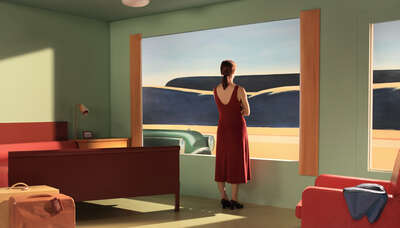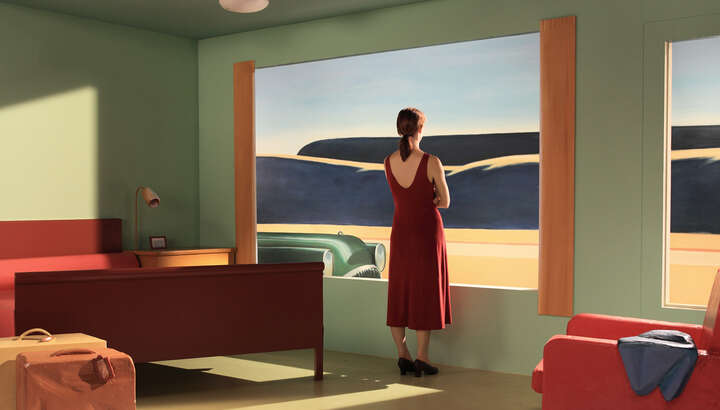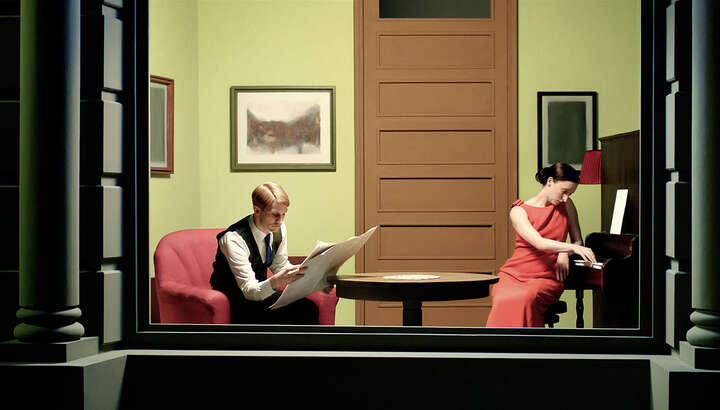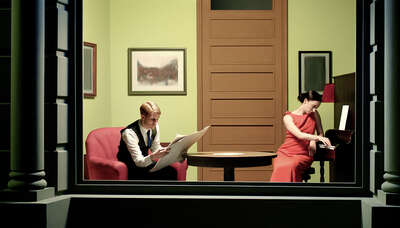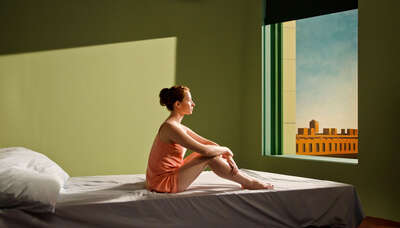Introduction
Drawing his own inspiration from film noir, Edward Hopper, the great master of American realism, influenced cinema to a nearly unparalleled extent: The Bates Motel in Hitchcock’s Psycho, David Lynch’s sombre visions of American suburbia, and Wim Wenders’ countless homages are all “Hopper-esque“, now a common descriptor for a distinctive film aesthetic.
This interaction between painting and cinematic storytelling shines through in the film Shirley – Visions of Reality by Austrian media artist Gustav Deutsch. The film has already won multiple Austrian Film Awards. Based on 13 of Hopper’s works, the film follows the life of fictional actress Shirley over a period of 30 years. What emerges is a portrait of America from the great depression through the McCarthy era to the civil rights movement – all intertwined with the protagonist’s personal story. In a series of atmospheric scenes, Deutsch brings Hopper’s paintings to life, continuing and expanding their inherent narratives. As natural as they may seem, Hopper’s pictures have also always felt a bit like film stills, their characteristic juxtaposition of light and shadow inspiring dramas to play out in our imaginations.
Although Deutsch satisfies some of our curiosity, he also preserves the enigmatic aura that makes Hopper’s figures so enchanting. The relationship between Shirley and her fellow travellers remains ill-defined, impenetrable, and characterized by a gentle melancholy.
The atmospheric scenes, with their captivating sense of excessive artificiality, are also the work of set designer Hanna Schimek, who helped Deutsch translate the picturesque quality of Hopper’s images into the medium of film. The duo succeeded in teasing out not only the narrative clues within the works, but also Hopper’s distinctive aesthetic.
In the Visions of Reality exhibition at the Vienna Künstlerhaus, Deutsch’s cinematic storyline was transformed into a synthesis of artistic endeavours; the exploration of the term “Hopper-esque” became an interdisciplinary project. With clear influences from the techniques of the tableau vivant, the diorama, and the trompe l’œil, Deutsch’s creative concept proposes a bridge between different artistic styles and questions our understanding of reality, illusion, and staging. The backdrops were conceived solely with the perspective of Hopper’s respective pictures in mind. In the three-dimensional space of a museum, the visitor can experience their actual distortions of perspective.
The set photos turn the moving medium back into static scenes, creating the impression of paintings once again. With his incisive style, Gustav Deutsch succeeds in bringing cinema and painting into a vibrant, interactive dialogue.
After studying and working as an architect, Deutsch began to devote himself to video art in the early 1980s – often in collaboration with his long-term partner Hanna Schimek. Deutsch’s style is characterized by an interdisciplinary approach, and his projects include film, architecture, installation, performance, music, and photography. He is internationally recognized as one of the major exponents of the original “found footage” genre – films constructed primarily from appropriated archived material. Shirley – Visions of Reality is Deutsch’s first feature film and has been shown at events such as the Berlinale Film Festival in Berlin.
Daniela Kummle
Bio
| 1952 | Born in Vienna, Austria |
| 1970-1979 | Studied Architecture at Vienna University of Technology, Vienna, Austria |
| 1983-Present | Member of the artist group “Der Blaue Kompressor” |
| 1984-Present | Worked with Hanna Schimek |
| 1989-2019 | Prolific filmmaker |
| 2020 | Died in Vienna, Austria |
Awards
| 2013 | Austrian Film Award |
| 2013 | Won the MehrWERT-Filmpreis der Erste Bank at the Viennale International Film Festival |
| 2005 | Best Film, EXiS Mediafestival, Seoul |
| 2002 | Curator’s Awards, Cinematexas Short Film and Video Festival |
| 2000 | Silver Spire Award, San Francisco International Film Festival |
| 1995 | Awarded the Anerkennungspreis from the Province of Lower Austria for artistic film |
Exhibitions
Solo Exhibitions
| 2013 | Gustav Deutsch und Hanna Schimek – Shirley der Film Visions of Reality die Ausstellung, Künstlerhaus Wien, Vienna, Austria |
| 2004 | Gustav Deutsch & Hanna Schimek – Atlas, Lentos Kunstmuseum Linz, Linz, Austria |
Group Exhibitions
| 2008 | Vertrautes Terrain – Aktuelle Kunst in und über Deutschland, Zentrum für Kunst und Medientechnologie, Karlsruhe, Germany |
| 2007 | Kino wie noch nie, Academy of the Arts, Berlin, Germany |
| 2006 | That’s not Entertainment, Centre de Cultura Contemporània de Barcelona, Barcelona, Spain |
| MozArt, Museum Moderner Kunst, Wörlen Foundation, Passau, Germany |
| Postmediale Kondition ARCO 2006, Museo Municipal de Arte Contemporáneo de Madrid, Madrid, Spain |
| Kino wie noch nie, Generali Foundation, Vienna, Austria |
| 2004 | Minority Report, Aarhus Festival of Contemporary Art, Aarhus, Denmark |
| Phonorama. Eine Kulturgeschichte der Stimme als Medium, Zentrum für Kunst und Medientechnologie, Karlsruhe, Germany |
| 2003 | Remembrance + the Moving Image Persistence of Vision, Australian Centre for the Moving Image, Melbourne, Australia |
| Einfälle und Abfälle, Galerie IG Bildende Kunst, Vienna, Austria |
